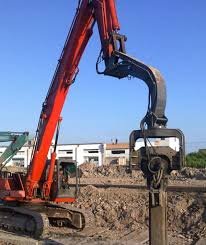A hydraulic vibratory hammer is one of the most important machines in construction work, especially when it comes to driving or extracting piles. These machines use hydraulic power and vibration to place piles deep into the ground or pull them out. Because they handle heavy jobs and work in tough environments, they face constant stress and wear. To make sure your hydraulic vibratory hammer lasts a long time and performs at its best, proper maintenance is necessary.
In this article, we will explain why maintenance matters, common areas that need attention, and practical tips for keeping your hydraulic vibratory hammer in excellent condition for many years.
Why Maintenance of a Hydraulic Vibratory Hammer Matters
Maintaining a hydraulic vibratory hammer is not just about avoiding breakdowns. It also brings several long-term benefits:
- Longer Equipment Life
Regular care helps reduce unnecessary wear, keeping the machine running longer. - Better Performance
A well-maintained hydraulic vibratory hammer works smoothly, delivers consistent vibration, and ensures piles are installed correctly. - Lower Repair Costs
Ignoring maintenance can lead to expensive breakdowns. Routine servicing prevents small issues from turning into major problems. - Safety
Construction sites are risky. Keeping equipment in good condition lowers the chance of accidents caused by sudden failures. - Reduced Downtime
When machines break down, projects stop. Maintenance helps avoid delays that can cost both time and money.
Key Areas to Maintain in a Hydraulic Vibratory Hammer
To take care of your hydraulic vibratory hammer, focus on the following parts and systems:
1. Hydraulic System
The hydraulic system powers the machine. Dirty or low-quality oil, leaks, or clogged filters can reduce power and damage internal parts.
2. Bearings and Joints
Since the machine vibrates constantly, bearings and joints take a lot of stress. They must be inspected, lubricated, and replaced when worn out.
3. Clamps and Grips
The clamps hold the pile securely. Worn or damaged clamps can cause slips, leading to poor performance or even accidents.
4. Vibratory Unit
The core of the hydraulic vibratory hammer is the unit that produces vibration. Keeping it aligned and balanced is critical for effective pile driving.
5. Cooling System
Hydraulic machines generate heat during operation. The cooling system must be kept clean and functional to prevent overheating.
6. Hoses and Connections
Hydraulic hoses and fittings carry the fluid under pressure. Cracks, leaks, or loose fittings can lower efficiency and risk sudden breakdowns.
Maintenance Tips for Long-Term Use
Here are simple but effective steps you can follow to extend the life of your hydraulic vibratory hammer:
1. Perform Daily Inspections
Before starting work each day, check the machine for leaks, loose parts, or unusual sounds. A quick inspection can catch problems early.
2. Use Clean Hydraulic Oil
Always use high-quality, clean hydraulic oil. Replace it as recommended and never allow dirt or water to mix with it. Dirty oil can damage pumps, valves, and cylinders.
3. Keep Filters Clean
Hydraulic filters should be checked and replaced regularly. Clean filters protect the hydraulic system from dust and particles.
4. Lubricate Moving Parts
Bearings, joints, and clamps must be greased often to reduce friction and wear. Lack of lubrication can cause premature failure.
5. Tighten Bolts and Nuts
The vibration of the hammer can loosen bolts and nuts over time. Regular tightening prevents parts from falling off or causing imbalance.
6. Inspect Hoses Frequently
Hydraulic hoses should be checked for cracks, bulges, or leaks. Replace damaged hoses immediately to avoid sudden breakdowns.
7. Monitor the Cooling System
Keep the cooling system clean and free of blockages. Overheating can damage seals, reduce efficiency, and shorten machine life.
8. Train Operators Properly
Many problems occur because of poor operation. Ensure that operators are trained to use the hydraulic vibratory hammer correctly, avoiding overloading and misuse.
9. Store Equipment Safely
When not in use, store the machine in a dry, covered place. Protecting it from extreme weather prevents rust and damage.
10. Follow Manufacturer Guidelines
Every hydraulic vibratory hammer comes with a manual. Following the recommended maintenance schedule is the best way to ensure long-term performance.
Common Mistakes to Avoid
While maintaining your hydraulic vibratory hammer, avoid these common mistakes:
- Skipping inspections – Small issues ignored today can cause major failures tomorrow.
- Using poor-quality oil – Cheap or contaminated oil damages the hydraulic system.
- Overusing the machine – Running the hammer non-stop without breaks leads to overheating.
- Ignoring operator training – Unskilled use can cause accidents and unnecessary wear.
The Long-Term Benefits of Proper Maintenance
By taking good care of your hydraulic vibratory hammer, you gain advantages beyond avoiding repairs:
- Projects finish on time because the machine is reliable.
- Safety improves, protecting workers and equipment.
- Investment value increases, as the machine lasts longer and retains more resale value.
- Productivity rises because the machine works at full efficiency.
Conclusion
A hydraulic vibratory hammer is a powerful tool in the construction industry, but like all heavy machines, it requires proper care. Maintenance is not just about fixing problems but preventing them. By inspecting daily, using clean hydraulic oil, keeping filters and hoses in good condition, lubricating moving parts, and ensuring skilled operation, you can extend the life of your machine.

